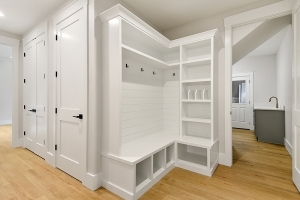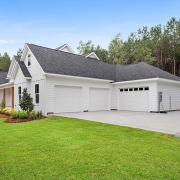Techniques Used to Strengthen Homes During High Winds
 Natural disasters are something everyone around the world fears. There are many construction techniques that have been tested and passed approval to improve the resistance of houses during high wind events such as less-severe (EFO-EF2) tornadoes and intense hurricanes.
Natural disasters are something everyone around the world fears. There are many construction techniques that have been tested and passed approval to improve the resistance of houses during high wind events such as less-severe (EFO-EF2) tornadoes and intense hurricanes.
Data has been collected two ways to see what products pass high wind conditions. The first way products are reviewed is by the Insurance Institute for Business & Home Safety (IBHS) which tests different products under controlled wind tunnel conditions. The second way data is collected is by post-storm assessments taken on what works during these high wind conditions by both the Insurance Institute for Business & Home Safety and the Engineered Wood Association (APA).
The International Residential Code® (IRC®) created by the U.S. Department of Energy is the ” Code for residential buildings that creates minimum regulations for one- and two-family dwellings of three stories or less. It brings together all building, plumbing, mechanical, fuel gas, energy and electrical provisions for one- and two-family residences.” Homes that have been built to the IRC code have shown high performance during high-wind events but builders are now finding ways to build homes that are above the IRC® standards.
Focusing on other ways to strengthen the roof and enable a “continuous load path through the structure to the foundation” can help builders build homes that can withstand high-risk tornadoes and intense hurricanes. By doing this, homeowners would be able to stay in their homes after a high-wind event and home repair cost would be lowered.
One way they have found to strengthen the roof is by sealing it. If air is kept from being able to seep underneath the roof components the roof will stay intact and not tear off. During a study IBHS did on homes in Florida after Hurricane Michael, those with sealed roof decks held up better than those that were not sealed. Taping the roof deck seams, using tighter nail spacing to fasten roof decking to trusses and rafters, using ring shank nails A, upgrading the underlayment to 30lb felt, properly fastening drip edges and gutters to minimize the ability of the wind to get up underneath roof covering and using self-adhered or synthetic underlayment are construction techniques used to strengthen roofs when homes are under construction.
There are many ways wind can damage a home. As mentioned previously uplift pressure can take the roof off, shear loads can cause a house to lean, and lateral loads can make the home slide off the foundation. Wind load is defined as the load in pounds per square foot placed on a structure by the wind. Builders are finding ways to allow a constant load path in the construction of homes. To prevent leaning wood structural panels or other structural sheathings (allowed by the IRC®) are used to brace walls, anchors are used against base shear and hold-downs are used against overturning. These types of construction techniques fight winds from tearing a home apart.
When building a home for a consumer, builders can take this information and inform them about these preventions. When living in a geographical area that is prone to these events, it is important for homeowners to be aware of the risk when not using these techniques or materials approved by the International Residential Code®.
Click Here For the Source of the Information.



